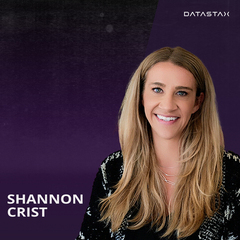CATEGORIES
DEI | Leadership and Networking | People We Admire | Women EmpowermentOverview:
- Shannon Crist shares powerful insights on bringing business knowledge and experience to human resources.
- In her experience, she’s seen that work culture should be built by both management and employees.
- Shannon talks about how DataStax’s inclusive assessment ensures an equitable and just workplace.
- She calls on young women to come out of their comfort zones and follow their gut feeling.
1. Can you talk about your childhood and the impact it’s had or how it shaped you?
I grew up in San Diego, California, with a military dad. My mom was a homemaker with the responsibility of five children. Despite that, she never let anything stop her. I vividly remember when she used to coach different soccer teams and would go out on the soccer field with a baby on her back. Her determination and grit have inspired me infinitely.
My dad was also a big part of my success. He went from an entry-level Navy man all the way up to a high-ranking officer. He was a self-taught engineer. He was always open to learning and teaching himself new things. Just seeing his strength in being away from his family for nine months at a time was proof enough of his resilience.
Both my parents were role models for me and shaped my character as an individual who is not afraid to work hard, take risks, and try new things.
2. Your journey is admirable but I am sure it has had its ups and downs. If you could go back in time, what are some things you would change or do differently?
Yeah, there are so many, an important one being my father’s death by suicide when I was in my early 20s. Mental health in the workplace subsequently became a big part of my passions. One of the things that inspired me to join tech was the alarming rates of mental health disorders and challenges.
I feel if maybe we recognize the signs early and provide the required support, we can save so many lives. As a society, we’ve come a long way. However in retrospect, I would have definitely talked more about mental health in the workplace and made an intentional effort to make it safe to talk about.
I would have spent more time saying the things that we generally shy away from addressing. Even when I didn’t necessarily understand, I could have done better to be curious and have conversations to seek to understand.
3. Managing people can be challenging at times. Have there been situations when you felt stressed out in dealing with people?
Yes, definitely. One stressful experience was when I worked at Adidas and led a remote team for the first time. This was pre-pandemic and I was appointed for a role where I was leading all of North America with the responsibility of leaders all across the country. I hadn’t met them personally or been in the market with them.
It was an abrupt shift where they moved a leader out and moved me in. It naturally felt like I needed to work harder to gain trust and credibility, especially because I had spent a decent amount of my time in human resources roles before moving into the business.
This role coached a team that was significantly bigger than my previous roles and was responsible for a half-a-billion-dollar P&L and a past history of not achieving goals for the last few years. Trying to build those relationships and connections and win people’s confidence from afar in a short period of time was one of the hardest things I had to navigate as a leader.
Making decisions on people and their roles with minimal insight and aligning a team to a common vision and purpose without the credibility of having done that exact job before, with expectations of me to have immediate results was most definitely one of the hardest things I have done in my career. I am very proud of my time in that role and the results we had, but it was far from easy and stress-free.
4. What advice would you give to companies that are looking to improve their employee experience and create a more engaged, inclusive, and motivated workforce?
I think one piece of advice that works is talking to your employees. The culture and perspectives they bring to the table make a company unique. DataStax is one of the very first companies where I felt I could be fully authentic in the interview process, which I feel is really important. Communicating with employees and figuring out what makes them tick is essential to enhancing the employee experience.
I view company culture as something that the employees and the leaders and coaches build together. For me, it’s really about their stories, the impact and their contributions that they’re looking to make to the company. Of course, engagement surveys and those other traditional people or HR things can provide insights, but I think truly getting to know who your people are is a critical part of that experience and that evolution.

5. How do you see Diversity, Equity, and Inclusivity (DEI) evolving in organizations today? What are some initiatives or practices you believe are crucial for organizations to adopt in order to create a truly inclusive and equitable workplace? And what is DataStax’s approach to such practices?
Data and metrics, especially at a data company, are important—but they are just metrics at the end of the day. Metrics without a clear purpose, actions, and outcomes can be meaningless to those you are trying to serve. At Datastax, one of our core values is to Execute thoughtfully with speed.
We relentlessly align on the “why” and move rapidly with the intention on the “how”. We do this because innovation and speed matters to those we serve, including our own team. With Diversity and inclusion it is important to take swift action and with your efforts, you also show tangible results beyond just reporting activities and data.
Employees should feel the difference from your efforts and actions, rather than making it a check-the-box activity. This means we must remain considerate of the things we’re doing, and here we strive to ground ourselves on why we’re doing it and the outcome we want from it.
If we look at it as a list of things we can report on at the year, it becomes a check-the-box activity, and we begin to lose sight of the humans involved. Those people are the real reason we are doing it, and if they don’t feel it and see it, then you are not hitting the mark.
At DataStax, we recently wrapped up an inclusion assessment to identify our biggest gaps and opportunities in creating a truly inclusive environment. We also have a culture equity team, where we bring partners, or a group of individuals, from the company that serve as the lens of our organization.
They provide feedback and insight on what they think would be most impactful to our teams. We do have a lot of progress to make, but it’s often the small and very intentional steps that really add up to those bigger milestones in the long run.
6. How do you respond to the equality issues that we’re still facing in the workplace? Have you gone through phases where colleagues underestimated you because of your gender?
I have definitely faced people underestimating me or my capabilities over the course of my career. Even as a white woman in the USA where we have diversity, equity, and inclusion as a part of the scope of almost every organization, I still experience doubt from others or feel others think I might not be the right person in a certain position specifically because of my gender.
To face that, I remind myself of the privileges I do have and of my proven track record of success in the results of my work that validates me. Additionally, I try to remind other people that we all have our strengths and opportunities, and we all have areas to grow.
I am not perfect and just like everyone else, I will get things wrong or make mistakes. To me it is about what you do with those mistakes. I don’t let doubt discourage me, I take it as a challenge and leverage it to motivate me even more. I love being able to prove people wrong when they doubt my abilities, but at the same time would love to see a time where the doubt isn’t influenced by my gender.
Accordingly, it’s our responsibility as human beings to connect, learn about one another, leverage each other, and provide opportunities to those who have earned them but may need more support with getting visibility or support with having a seat at the table.
7. Outside of work, how do you unwind or find happiness and peace?
It’s funny to ask that because I’m one of those people who find happiness and peace in taking on more responsibilities and filling out any excess time I have. In fact, outside of my real work, I own a couple of small hobby companies that started at little time fillers and grew into successful small businesses. I also help my kids with their entrepreneurial spirit as well. My son’s have a shaved ice business they operate in the summer where they learn about every detail of running a business.
However, what really helps in this chaotic life is that I found a work-life blend. Unlike work-life balance, where I was striving to separate different aspects of my life, I look for ways to blend them. I have been able to achieve fulfilment and happiness by blending my work-life and personal life.
I can go from a morning full of zoom meetings to an afternoon of volunteering in the classroom with my kids and then return home to have strategic thinking time. It’s more fluid and allows me to be fully present at whatever I am choosing to focus on.
What brings me the most peace and happiness is spending time with my family. I truly cherish the smallest moments with my kids. Things like sitting at the dinner table as a family, walking down to the park, or even driving them around to all their different sports practices or games.
To me, what’s most meaningful in these moments are the simple conversations that allow me to get to know them as humans and see them grow as individuals.
Conclusion:
Shannon takes us on a journey of how she was brought up in a family of leaders who taught her to always learn more and assume responsibility. She shows us the importance of mental health in the workplace and how empathy helps us all move forward collectively. She encourages us to pursue the things that terrify us and reminds us that growth begins at the end of our comfort zone.


